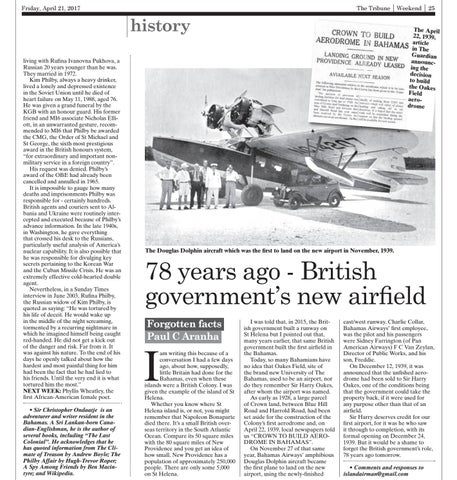The Tribune | Weekend | 25
Friday, April 21, 2017
history living with Rufina Ivanovna Pukhova, a Russian 20 years younger than he was. They married in 1972. Kim Philby, always a heavy drinker, lived a lonely and depressed existence in the Soviet Union until he died of heart failure on May 11, 1988, aged 76. He was given a grand funeral by the KGB with an honour guard. His former friend and MI6 associate Nicholas Elliott, in an unwarranted gesture, recommended to MI6 that Philby be awarded the CMG, the Order of St Michael and St George, the sixth most prestigious award in the British honours system, “for extraordinary and important nonmilitary service in a foreign country”. His request was denied. Philby’s award of the OBE had already been cancelled and annulled in 1965. It is impossible to gauge how many deaths and imprisonments Philby was responsible for - certainly hundreds. British agents and couriers sent to Albania and Ukraine were routinely intercepted and executed because of Philby’s advance information. In the late 1940s, in Washington, he gave everything that crossed his desk to the Russians, particularly useful analysis of America’s nuclear capability. It is also possible that he was responsible for divulging key secrets pertaining to the Korean War and the Cuban Missile Crisis. He was an extremely effective cold-hearted double agent. Nevertheless, in a Sunday Times interview in June 2003, Rufina Philby, the Russian widow of Kim Philby, is quoted as saying: “He was tortured by his life of deceit. He would wake up in the middle of the night screaming, tormented by a recurring nightmare in which he imagined himself being caught red-handed. He did not get a kick out of the danger and risk. Far from it. It was against his nature. To the end of his days he openly talked about how the hardest and most painful thing for him had been the fact that he had lied to his friends. Until the very end it is what tortured him the most.” NEXT WEEK: Phyllis Wheatley, the first African-American female poet. • Sir Christopher Ondaatje is an adventurer and writer resident in the Bahamas. A Sri Lankan-born Canadian-Englishman, he is the author of several books, including “The Last Colonial”. He acknowledges that he has quoted information from The Climate of Treason by Andrew Boyle; The Philby Affair by Hugh-Trevor Roper; A Spy Among Friends by Ben Macintyre; and Wikipedia.
The April 22, 1939, article in The Guardian announcing the decision to build the Oakes Field aerodrome
The Douglas Dolphin aircraft which was the first to land on the new airport in November, 1939.
78 years ago - British government’s new airfield Forgotten facts Paul C Aranha
I
am writing this because of a conversation I had a few days ago, about how, supposedly, little Britain had done for the Bahamas, even when these islands were a British Colony. I was given the example of the island of St Helena. Whether you know where St Helena island is, or not, you might remember that Napoleon Bonaparte died there. It’s a small British overseas territory in the South Atlantic Ocean. Compare its 50 square miles with the 80 square miles of New Providence and you get an idea of how small. New Providence has a population of approximately 250,000 people. There are only some 5,000 on St Helena.
I was told that, in 2015, the British government built a runway on St Helena but I pointed out that, many years earlier, that same British government built the first airfield in the Bahamas. Today, so many Bahamians have no idea that Oakes Field, site of the brand new University of The Bahamas, used to be an airport, nor do they remember Sir Harry Oakes, after whom the airport was named. As early as 1928, a large parcel of Crown land, between Blue Hill Road and Harrold Road, had been set aside for the construction of the Colony’s first aerodrome and, on April 22, 1939, local newspapers told us “CROWN TO BUILD AERODROME IN BAHAMAS”. On November 27 of that same year, Bahamas Airways’ amphibious Douglas Dolphin aircraft became the first plane to land on the new airport, using the newly-finished
east/west runway. Charlie Collar, Bahamas Airways’ first employee, was the pilot and his passengers were Sidney Farrington (of Pan American Airways) F C Van Zeylan, Director of Public Works, and his son, Freddie. On December 12, 1939, it was announced that the unfished aerodrome had been sold to Sir Harry Oakes, one of the conditions being that the government could take the property back, if it were used for any purpose other than that of an airfield. Sir Harry deserves credit for our first airport, for it was he who saw it through to completion, with its formal opening on December 24, 1939. But it would be a shame to forget the British government’s role, 78 years ago tomorrow. • Comments and responses to islandairman@gmail.com
